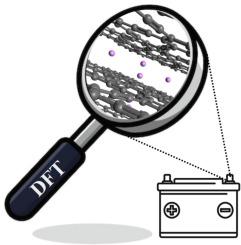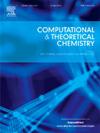Ɣ-Graphyne作为Li+, Na+和K+金属离子电池阳极的可能候选材料
IF 3
3区 化学
Q3 CHEMISTRY, PHYSICAL
引用次数: 0
摘要
采用密度泛函理论(DFT)方法系统地研究了碱离子Li+、Na+和K+与GY表面的相互作用。利用cam-B3LYP和PBE泛函进行高阶DFT计算,建立了相互作用能、电荷转移机制和电池电压值的模型。为了更全面地理解所研究的现象,采用了聚类和周期边界条件模型。这种组合方法利用了两个模型的优势,提供了对结构的更深入的了解。以及材料的电子特性。每个离子在不同位置在GY表面的吸附被检测,显示优先吸附在GY三角形结构的中心,计算出的吸附能范围为−2.98至−1.69 eV。值得注意的是,周期模型产生的吸附能比簇模型高约30 - 45%(更稳定)。此外,我们的结果表明,带隙能量可以通过改变离子相对于GY表面的相对位置来调节。最后,对电池电压值进行了分析,以评估GY同素异形体作为离子电池阳极材料的潜力。本文章由计算机程序翻译,如有差异,请以英文原文为准。

Ɣ-Graphyne as a possible candidate for Li+, Na+, and K+ metal ion battery anode
A systematic theoretical study employing Density Functional Theory (DFT) approaches has been conducted to investigate the interaction of alkali ions Li+, Na+, and K+ with the GY surface. Interaction energies, charge transfer mechanisms, and cell voltage values were modeled using high-level DFT calculations with the cam-B3LYP and PBE functionals. Both cluster and periodic boundary condition models were employed to provide a more comprehensive understanding of the phenomena under investigation. This combined approach leverages the strengths of both models, offering a deeper insight into the structural.
and electronic properties of the material. Adsorption of each ion on the GY surface was examined at various positions, revealing a preference for adsorption at the center of the GY triangular structure, with calculated adsorption energies ranging from −2.98 to −1.69 eV. Notably, the periodic model yielded adsorption energies that were approximately 30–45 % higher (more stable) compared to the cluster model. Furthermore, our results demonstrate that the band gap energy can be tuned by varying the relative position of the ions with respect to the GY surface. Finally, an analysis of the cell voltage values was performed to evaluate the potential of the GY allotrope as an anode material for ion batteries.
求助全文
通过发布文献求助,成功后即可免费获取论文全文。
去求助
来源期刊

Computational and Theoretical Chemistry
CHEMISTRY, PHYSICAL-
CiteScore
4.20
自引率
10.70%
发文量
331
审稿时长
31 days
期刊介绍:
Computational and Theoretical Chemistry publishes high quality, original reports of significance in computational and theoretical chemistry including those that deal with problems of structure, properties, energetics, weak interactions, reaction mechanisms, catalysis, and reaction rates involving atoms, molecules, clusters, surfaces, and bulk matter.
 求助内容:
求助内容: 应助结果提醒方式:
应助结果提醒方式:


